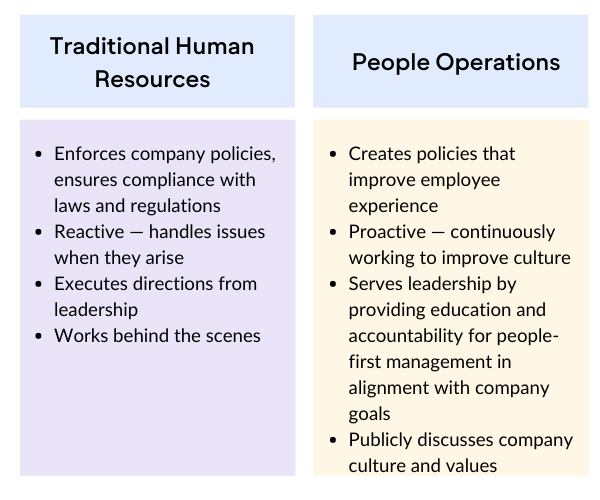What’s the difference between people operations and human resources? People and humans are the same things, right? Not quite; at least not in the workplace.
What started as a difference in branding has become a distinction in what takes precedence. People operations approaches decisions by thinking about team members, then building processes around them. Human resources works through the lens of processes, then addresses the people aspect.
Neither department is the “better” choice. In fact, larger teams may even have both human resources and people operations teams. But no matter how big or small your company is, it’s helpful to understand the nuances in how the two teams approach work.
People operations and human resources teams have many overlapping duties, but the terms are not interchangeable. The teams have different priorities. Determining which is a better fit for your company is important because it will influence how you run your company and manage your team members.
What People Operations and Human Resources Have in Common
On a day-to-day basis, duties for both people operations and human resources roles can look similar.
Recruiting and Hiring
Both departments are responsible for attracting, sourcing, and hiring the right talent. Large teams often have dedicated recruiters who spend their days seeking top talent and encouraging promising candidates to apply. Smaller teams tend to include recruiting as part of a general people operations or human resources role. Either way, both teams handle all things related to staffing.
People operations and human resources teams are in charge of interviewing as well. In practice, this could mean running the interviews with potential candidates and/or scheduling interviews with relevant managers. For example, a people operations or human resources manager might do the initial interview with a candidate and then funnel them to the proper department head for a second interview.
Onboarding Employees
New hires have a lot to learn and are sure to have plenty of questions. Newbies can turn to people operations and human resources teams for anything related to the employee onboarding process.
Onboarding includes an introduction to company tools, workflows, and processes. People operations and human resources teams support onboarding in a variety of ways. They make sure new employees are set up on everything from Slack to internal task management tools. They also introduce new hires to their immediate peers and direct supervisor. And both teams serve as the go-to resource for questions about company culture and policies. Basically, if any team member has questions about how your company does X, people operations or human resources should either have the answer or know how to find it.
Administering Salaries and Benefits
Can team members expense home-office equipment? Are employees paid biweekly or monthly? Can paternity leave be used to care for a new puppy? These are all part of the people operations/human resources purview.

Even though larger organizations might have a dedicated accounting department, people operations and human resources are still involved with payments. They’re the people who make sure everyone’s hourly/contractor rates, salaries, and bonuses are properly tracked and administered.
Both departments are responsible for benefits, such as health insurance, 401Ks, and vacation/sick days. People operations and human resources will either deal with questions internally or point team members to the right person for third-party questions. For instance, if a team member wants to know if the company’s health insurance will cover acupuncture treatments, they’ll be directed to the insurance provider. But if the question is about whether lower-back pain is grounds for a sick day, that’s an internal policy concern.
Let’s not forget about perks! Gym membership reimbursements, donut surprises, stipends for enrichment (conferences, books, etc.), and all those fun extras are part of company benefits.
Want to be a better manager with a happier, healthier and more effective team?
Sign up for a free coaching consultation with Uptick Co-founder Chris Zaugg to improve your team’s effectiveness by connecting relationally.
Enforcing Company Policies and Procedures
Both departments are responsible for keeping employees informed of company guidelines and enforcing business policies.
Your people operations and human resources teams should own all things related to employee conduct. They’ll enforce policies for harassment, workplace fraternization, workplace behavior, dress code, etc. The departments are also in charge of disciplinary procedures and resolving conflicts between team members.
Although neither department creates schedules for team members, the departments would be involved in how schedules are enforced. For example, if your company is strictly 9-5, and Brad tends to stroll in around 9:30 every morning — that’s a people operations/human resources concern. Similarly, if your company is all about flexible schedules, the departments would set those expectations. They would also design rules for remote work, such as bring your own device (BYOD) policies or home office stipends.
Managing Employee Experience
These teams are responsible for your employees’ overall experience with the company — from hiring through moving onto a new organization. As such, people operations and human resources teams will own decisions related to work environments, company culture, employee engagement, and retention efforts.
Work environment can refer to a physical office as well as technology and resources. For example, determining which tool to use for performance reviews or budgeting for new office chairs.

Company culture is an essential aspect of people operations and human resources work. Your company’s values and guiding principles help current and potential team members figure out if they’re a good fit for your organization. Culture also affects employee engagement and retention efforts. For example, someone who values autonomy in the workplace would appreciate a company that promotes asynchronous communication.
What Sets People Operations and Human Resources Apart
To put it simply: People operations is people-first, while human resources is process-first.

Enforcing vs. Creating Policies
Traditional human resources departments focus on compliance, liability, and managing processes. Whatever rules the company has, human resources will prioritize enforcing them. Basically, they have an employee handbook, and they are sticking to it.

People operations teams, on the other hand, shift the focus to the people behind the process — the employees. Plus, people operations departments not only enforce policies but also design them. And because their main objective is to improve the employee experience, those policies aim to build happy teams. It’s the difference between setting up Slack for remote team communication (process) and creating Slack channels for non-work-related interests to encourage casual conversation among team members (people).
Reactive vs. Proactive
Let’s say Aram announces he’s going to be a father and can’t wait to spend time with his newborn. But it turns out the company doesn’t offer paternity leave. Human resources is reactive, so they’re likely to deal with situations like this on a case-by-case basis. Aram might end up with paternity leave, but that doesn’t necessarily mean human resources would implement a company-wide policy for similar situations in the future.
Meanwhile, people operations would probably use Aram’s wonderful news as inspiration to create a formal paternity leave policy. And while they’re at it, maybe they’ll talk to the team about related policies, such as parental leave for fostering children or health care coverage for undergoing IVF treatments.
Either department could give Aram time off to hang out with his new baby. But people operations would likely take it a step further and proactively create policies for other team members in related situations.
Receiving Direction vs. Providing Direction
Think of human resources as rule enforcers. If leadership says no stipends for educational materials, human resources will run with that direction. Sorry, Franco, you’ll need to pay for that management book out of your own pocket. Human resources’ hands are tied.
People operations teams are creators. They look for ways to support employees and make the company a better place to work. Instead of relying on leadership’s direction, people operations will go to leadership with recommendations. Let’s say leadership sets a goal to increase internal promotions by 50% in the next year. People operations would research how to support that goal. Then, they’d go to leadership with suggestions. In this case, the team might recommend creating a budget for management training and educational materials for emerging leaders. Congratulations, Franco, that book is now a work expense.
Behind the Scenes vs. Transparent
Employees rarely hear about the inner workings of human resources. It’s even less likely that potential employees would know much about a human resources department before getting to the interview stage. These departments work behind the scenes and get involved with team members on an as-needed basis.
Meanwhile, people operations is out in the open. These teams actively promote the company to attract top candidates. Employer branding is a much bigger focus for people operations teams, so they need to be more transparent about what it’s like to work at the organization.
They also engage with current team members on a regular basis. People operations teams interact with employees so they can plan team-building activities, consult on professional development plans, and continuously support people at work.

Remember, the difference between people operations and human resources boils down to priorities. One strives to view team members as whole people who have lives outside of work. The latter concentrates only on the at-work experience. Of course, this doesn’t mean human resources doesn’t care about people. However, it does narrow the scope of their work.
Take work-life balance, for example. Both departments care about this, but they’d approach it differently based on their priorities. Because people operations teams put people first, they’re more likely to proactively set boundaries between work and personal time.
Human resources, on the other hand, would wait until they had further direction from leadership or feedback from team members. So if several people mention poor work-life balance as a reason for leaving during their exit interviews, human resources would take action to prevent additional employee departures.
The end result is the same — team members get work-life balance policies — but the departments have different motivations.
Why People Operations Is Growing
Although human resources isn’t getting canceled by any means, many companies are realizing that the department lacks one major thing — a human aspect. And studies increasingly show that when you support the people behind the work, the entire company benefits.
People operations sets goals to improve employee engagement, reduce turnover, and create more desirable work environments for current and future team members. And it’s not just because that’s great for employees. Companies with high levels of employee satisfaction retain top performers and reduce costly turnover.
With people operations, there’s more room for innovation and improvement compared to traditional human resources. For example, people operations teams often work closely with managers and leadership to design professional development plans that go beyond the current positions available. They’re thinking ahead to make sure team members have space to grow.
What This Means for Managers
For people in management positions, the distinction between human resources and people operations can influence how they work with their teams and what support they receive from leadership.
Human resources will give managers a policy and help them enforce it. In general, this department will concentrate on protecting the company rather than serving the employees. As such, they’re more likely to refer managers to rule books versus coming up with creative solutions. If managers want to adjust a policy, they’ll need to show human resources how that policy change will benefit the company.
People operations leaders are strategic partners for employees. They exist to build better processes, provide training and guidance, and help managers become better leaders. Leadership relies on people operations to create policies and bring new ideas to them versus leadership telling people operations what to do. If managers hope to influence policies, they’ll need to highlight how policies benefit the people at work.
Who Should Be In Charge of One-on-Ones?
The short answer? All three. Of course, people operations, human resources, and managers all play a different role in one-on-ones.
Human resources and people operations set the rules — who meets with whom, how often, and for what purpose. Managers run the one-on-ones with their direct reports. But let’s not forget about the employees themselves. Team members and managers share ownership of one-on-ones. After all, it’s the team member’s career path on the agenda.
How Do You Manage Your Team?
People operations and human resources may approach things differently, but both teams are responsible for the employee experience. No matter what their priorities are, the two teams have a lot of moving parts to manage on a daily basis. Without the right tools and processes, it’s easy to lose sight of long-term goals.
To set your people operations/human resources team as well as your managers up for success, you need a way to keep track of professional development and employee engagement. Uptick can keep all of those long-term plans organized in a central platform. Start building better teams with the help of our one-on-one templates, conversation prompts, goal tracking, and more.
Want to be a better manager with a happier, healthier and more effective team?
Sign up for a free coaching consultation with Uptick Co-founder Chris Zaugg to improve your team’s effectiveness by connecting relationally.
